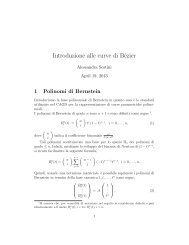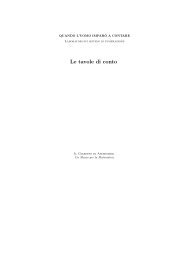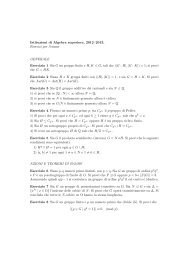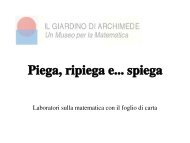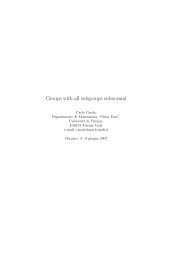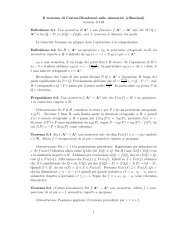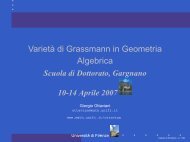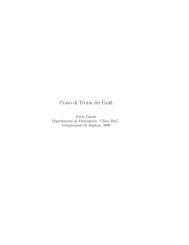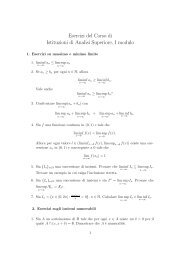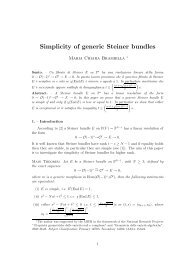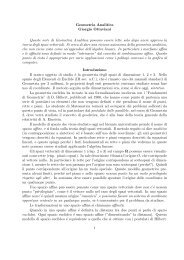Create successful ePaper yourself
Turn your PDF publications into a flip-book with our unique Google optimized e-Paper software.
TRANSACTI<strong>ON</strong>S OF THEAMERICAN MATHEMATICAL SOCIETYVolume 307, Number 1, May 1988<strong>SPINOR</strong> <strong>BUNDLES</strong> <strong>ON</strong> <strong>QUADRICS</strong>GIORGIO OTTAVIANIABSTRACT. We define some stable vector bundles on the complex quadrichypersurface Qn of dimension n as the natural generalization of the universalbundle and the dual of the quotient bundle on Q4 ~ Gr(l,3). We call themspinor bundles. When n = 2fc — 1 there is one spinor bundle of rank 2k~1.When n = 2k there are two spinor bundles of rank 2k~1. Their behavioris slightly different according as n = 0 (mod 4) or n = 2 (mod 4). As anapplication, we describe some moduli spaces of rank 3 vector bundles on Q5and Qe-Introduction. Let Qn be the smooth quadric hypersurface of the complex projectivespace Pn+1.In this paper we define in a geometrical way some vector bundles on the quadricQn as the natural generalization of the universal bundle and the dual of the quotientbundle on Q4 ~ Gr(l,3). We call them spinor bundles. On Q4 this definition isequivalent to the usual one.Spinor bundles are homogeneous and stable (according to the definition of Mumford-Takemoto).We study their first properties using the geometrical descriptiongiven and some standard techniques available in [OSS].We also use a theorem of Ramanan (see [Um]) about the stability of homogeneousbundles induced by irreducible representations. When n is odd there is onlyone spinor bundle, while when n is even there are two nonisomorphic spinor bundles.When n is even the behavior of spinor bundles is slightly different accordingas n = 0 (mod4) or n = 2 (mod4).In [Ot2] we have given a cohomological splitting criterion for vector bundles onquadrics involving spinor bundles.Qn ~ Spin(n + 2)/P(cty) [St] is a homogeneous manifold, and the semisimplepart of the Lie algebra of -P(ai) is o(n). At the level of Lie algebras, spinor bundlesare defined from the spin and half-spin representations of o(n).The paper is divided into three sections. In §1 we give some preliminary resultsand we define the spinor bundles. In §2 we study the first properties of spinorbundles. In §3, as an application, we describe some moduli spaces of rank 3 vectorbundles on Q5 and Qq.1. Geometrical definition of spinor bundles on Qn- For basic facts aboutvector bundles we refer to [OSS]. We set E(t) = E ®oQn 0Qn(i) for t E 1 whenReceived by the editors March 31, 1987.1980 Mathematics Subject Classification (1985 Revision). Primary 14F05; Secondary 14M17,32M10.Key words and phrases. Vector bundle, homogeneous, stable, spinor, moduli space.This paper was written while the author was enrolled in the Research Doctorate of the Universityof Florence. Partially supported by MPI 40% funds.301©1988 American Mathematical Society0002-9947/88 $1.00 + $.25 per page
302 GIORGIO OTTAVIANIE is a vector bundle on Qn. The first Chern class of E can be considered as aninteger. We denote by E* the dual vector bundle of E. If F is a sheaf on a varietyX, we denote by hl (X, F) the dimension of the complex vector space Hl (X, F).We will recall some facts about linear spaces of maximal dimension on Qn [GH,Chapter 6; LV, pp. 16-17].The situation is different for quadrics of odd or even dimension. If n = 2fc is even,then the linear spaces of Qn of maximal dimension have dimension fc. There aretwo disjoint families of fc-planes on Qn, each parametrized by a smooth irreducibleprojective variety Sk (called spinor variety) of dimension fc(fc + l)/2. We have:Pic(Sfc) ~ Z and if Osk(l) is the ample generator, then //°(S&, Osk(l)) = C2 .If n = 2fc + 1 is odd, then the linear spaces on Qn of maximal dimension havedimension fc. There is only one family of fc-planes on Qn which is parametrized bySk+i-It is well known that Si ~ P1, S2 ~ P3.Let Q2k+2 n // = Q2k+y with H a nontangent hyperplane. The natural map{Pfc+1 I Pfc+1 c Q2k+2} -pk+l ^ pfc+1 nH{Pk I Pk c Q2k+1},is 2 : 1 and is an isomorphism when restricted to each connected component ofrpfc+i | pfc+i c Q2k+2), Observe that if Pk+1 C H for some Pfc+1, then H wouldbe tangent to Q2fc+2, so that (1) is well defined.If x E Qn, the linear spaces on Qn of maximal dimension which contain x arein a natural bijective correspondence with the linear spaces of maximal dimensionon Qn-2 — Qn n TxQn fl //, where TxQn is the tangent space to Qn in x and H isa generic hyperplane. In fact TxQn (lQn is a cone with vertex in x over a smoothquadric Qn-2.PROPOSITI<strong>ON</strong> 1.1. Let Q2k+y^H = Q2k, where H is a nontangent hyperplane.We have {Pk | Pfc C Q2k} — S'k U S'k, so that we have two natural embeddingsi': S'k -* Sk+y and i": S'k' -» Sfc+ll where Sk+y =2 {Pfc | P* C g2fc+i}.Then i'*0sk+l(l) — 0_
<strong>SPINOR</strong> <strong>BUNDLES</strong> <strong>ON</strong> <strong>QUADRICS</strong> 303For the second assertion, since H°(Sk+i, 0(1)) and H°(S'k,0(l))®H°(S'k\ 0(1))are vector spaces of the same dimension 2fc+1, it is sufficient to prove that therestriction map is injective.We use induction on fc. If fc = 1, then i'(S'y) and i"(S[') are two skew lines inP3, so that the assertion is true.Suppose that the assertion is false for fc+ 1: we have s E H°(Sk+2, 0(1)), s^O,such that s[sk t = 0, s|s« i = 0. Let Pk+1 c Q2fc+3 such that s(Pk+l) ^ 0 andlet x E Pk+1 n H. Then{Pfc+! |xePfc+1 cQ2fc+3n//} ^ {Pk+1 | x e Pk+1 c Q2fc+3}» l\S'k U Skand we obtain the natural commutativediagram:S'k U,Sfc' -► Sk+yI 1S'k+1 U Sk+1 -* Sk+2Sk+yWe have s \s ^ 0 because Pfc+1 g Sk+y, but s |j;,= s |g» = 0, contradicting theinduction hypothesis. This completes the proof.COROLLARY 1.2. (i) LetxEQ2k+y and consider(Sk% ■= {Pk I x E Pk C Q2k+y} ^ {Pk | Pfc C Q2fc+i} = Sk+y.Then ix0sk+1(l) ~ 0(sk)x(i) and the restriction mapis surjective.(ii) Let x E Q2k and considerH°(Sk+y,0(l))^H°((Sk)x,0(l))iS'k-i)x U (_?£__), = {Pk|xePfcC Q2k} ^ {Pk | Pk C Q2fc} = S'k U S£:jx induces two embeddings:Jx '■ i$k-y)x —* Sk, Jx : (Sk-y)x —* Sk.Then j'*0s'(l) — 0(S'_ )(!)> 3x*0s"(l) —
304 GIORGIO OTTAVIANIIn case (ii), we cut with a hyperplane H, so that from map (1) we go back againto case (i).Consider now the quadric Q2k+y- From Corollary 1.2, for each x E Q2k+y wehave an inclusionH°((Sk)x, 0(1))* ^ H°(Sk+y, 0(1))*and then an embedding s:Q2fc+i —> Gr(2fc - l,2fc+1 - 1) in the Grassmannian of(2fc- l)-subspaces of P2*+1-1.In the same way, in the case of even dimension, from Corollary 1.2 we have thetwo embeddingss': Q2k - Gr(2fc~1 - 1,2k - 1), s": Q2k -» Gr(2fc-X - 1,2k - 1).DEFINITI<strong>ON</strong> 1.3. Let U be the universal bundle of the Grassmannian. We calls*U = S the spinor bundle on Q2k+y- Its rank is 2k. We call s'*U = S' ands"*U ^ S" the two spinor bundles on Q2k- Their rank is 2k~1.If / is an automorphism of Q2k that exchanges the two families of fc-planes, wehave f*S' =_ S" and f*S" s_ 5'.It is clear that spinor bundles S on all quadrics Q are homogeneous, i.e., f*S ~S V/ E Aut(Q)0, where Aut(Q)0 is the connected component of the identity inAut(Q).From the geometrical description given, the following theorem is clear.THEOREM 1.4. (i) LetS', S" be the spinor bundles onQ2k, and leti:Q2k-y —* 3) be a line and let S be a spinor bundle on® 0t(-ir2Un'3)/21.2. First properties of spinor bundles on Qn- Now let n — 2fc + 1 andconsider the connected, simply connected, simple Lie group Spin(n + 2) = Gn- Wefix a maximal torus T C Gn. The Lie algebra of Gn is o(n + 2) and the Lie algebraof T is a Cartan subalgebra of o(n + 2) which we denote by f).Let $ be the set of roots of o(n+2) relative to 1), and let a_,... ,otk+y be a subsetof simple roots, so that every root a E $ can be written as an integral combination
<strong>SPINOR</strong> <strong>BUNDLES</strong> <strong>ON</strong> <strong>QUADRICS</strong> 305a — "Y^iZy ni°-i with either all n* > 0 or all rii < 0. This divides the set of rootsinto two disjoint subsets, the positive roots $+, and the negative roots -.Let ( , ) denote the natural inner product on f)* induced by the Killing form.Let Xy,..., Afc+i € h* be the fundamental weights, characterized by the property2(Xi,ctj)/(otj, aj) = 8ij. We also denote by A^ the corresponding fundamentalweights which act on T.Associated to the set of simple roots ay,..., ak+y is the Dynkin diagram Bk+y.Let ga C o(n + 2) be the eigenspace for a root a. If A C {qi, ..., ak+y} we define$+(A) = {a E $+ | a = £?_!_ "«««. m = 0 for a* € A}. Let P(A) be the standardparabolic subgroup of Gn whose Lie algebra is rj © (0Q€$- ga) © (0_e_.+ (A) 9a)-Consider the incidence variety F := {(_, Pfc) E Qn x Sk+y | x E Pk C Qn}-We have two surjective projections as follows:w '/ '
306 GIORGIO OTTAVIANIPROOF. We could apply the theorem of Bott, but we prefer to give a simpleinductive argument.For n = 1,2 the theorem is well known. So we proceed by induction on n. Let5 be a spinor bundle on Qn+y- Consider the exact sequences on Qn+i'-0 — S(t - 1) -* S(t) -> S [Qn(t) -> 0 for all t E I.From the induction hypothesisand Theorem 1.4 we haveThenH\Qn,S \Qn (t)) = 0 for i such that 0 < i < n, for all t E Z,H°(Qn,S\Qn(t)) = 0 iortpwhich converges tof E for i = 0,El = \[ 0 otherwise.
<strong>SPINOR</strong> <strong>BUNDLES</strong> <strong>ON</strong> <strong>QUADRICS</strong> 307In our case Ev{" = E%q = E, so that a filtration of E results: 0 = E0 C Ey C■ • • C En = E with Et subsheaves such thatConsider the sequencei=0 p=0 t=00 -» Ey -> E2 -» £_/£i -» 0.By [At], we have Ey :_ fip(p), E2/Ey ~ n?(g) for some p, g. By Lemma 2 of[Be]:Ext1(f]«(g),nP(p)) = 0, so that E2 ~ fF(p) © fl«(.).Exactly in the same way it follows that each subsheaf Ei is a direct summandof Ei+y, and this completes the proof.THEOREM 2.5. Let S be a spinor bundle on Q2m+i and consider a linear spacePmCQ2m+y. ThenS\pm=®=0Wpm(i).PROOF. The proof is by induction on m. For m = 1 the result is well known.By Lemma 2.4 it is sufficient to show that{C for 0 < i = j < m,0 for 0 < i, ji < m,i ^ j.Consider a linear space Pm+1 D Pm. Then Pm+1 n Q2m+y = Pm U Pm := X andwe have an exact sequence of Mayer-Vietoris type [Ba](3) 0 -» Ox -» Opm © 0pm -» 0y - 0where F = Pm n Pm ~ Pm_1.Consider a generic linear space P2m C P2m+2 such that P2m D Y. Thenpm n P2m = y P2m n Q2m+1 _ Q2m_x smooth quadric.We get the commutative diagram:Thus by TheoremY -► Q2m-1IIPm -► Q2m + 11.4 5 \y— SQ2m_l |y ®Sq2„1_1 \y, where SQ2m_l is the spinorbundle on Q2m-y. By the induction hypothesis, 5,
308 GIORGIO OTTAVIANIh(X,S\x(-3))=l°+1 f°r^m-1'V IX V J I) | 2m+i fory = mIf we tensor (3) by 5 and consider the associated cohomology sequence we getH*(Pm,S\pm(-3))®IP(P,S\,m(-3)) = \^ ?0nZi=.i-m' ■[0 for 0 < 1,3 < m, i ^ 3.As S is homogeneous,we have S \pm — S |pm. This completes the proof.THEOREM 2.6. (i) Let S', S" be the spinor bundles on Q4m. The restrictionsto one family of linear P2m c Q4m arewhile the restrictionsm m—1s' |p2m^ 0"p-(2O, s" \p2mc 0 n2p\t\2i +1),i=0 i=0to the other family of linear P2m C Q4m arem-ls' lP2^ 0 nP^t.1(2z + i), S" |pa_~ 0O2U2i).i=0 t=0(ii) Let S', S" be the spinor bundles on Q4m+2. The restrictions to one familyof linear p2m+1 c Q4m+2 aremS |p2m+l— ^J7"p2m+1 (2l), S | p2m+l — ^J7 ^p2m+1 (2« + 1),1=0 i=0while the restrictionsto the other family of linear p2m+1 c Q4m+2 aremS |p2m+l— ^J7"p2m+i (2l + 1), S |p2m+l— ^J7"p2m + l (2z).i=0 i=0PROOF. Let Pfc C Q2k be a linear space. From Theorems 1.4 and 2.5 it followsthat S' © S" |pfc~ ©*Lonp*(0. By [At] S' and S" must decompose on Pfc withdirect summands Qpk(i) for some i.Consider now a hyperplane Pfc_1 C Pfc. As fipfc(l) |pt-i^ np^^l) © 0P*-i,from the canonical isomorphism /\n(A © B) = ©"=0(AJ A /\n~] B) (A,B vectorbundles) we getnU(*) |P*-i- nP*-' (0 © npl-i(i -1).By Theorem 1.4, S' |p„_i— 5"' |p„_i, so that it follows that the only possibledecompositions are those stated.LEMMA 2.7. Let Ey, E2 be semistable vector bundles on Qn with rankEy =rank_?2, cy(Ey) = cy(E2). Let at least one of Ey, E2 be stable. Then„ ( 0 if and only if Ey,E2 are not isomorphic,h"(Qn,E*®E2) = \ .......„„ ,.[1 if and only if Ey, E2 are isomorphic.mmmPROOF. It is a straightforwardTheorem 1.2.9, pp. 171-172].extension of [OSS, corollary of Lemma 1.2.8 and
<strong>SPINOR</strong> <strong>BUNDLES</strong> <strong>ON</strong> <strong>QUADRICS</strong> 309THEOREM 2.8. (i) Let n = 2m + 1 and let S be the spinor bundle on Qn. Wehave a natural exact sequence:0 - S - 0$r+l - 5(1) -» 0and an isomorphism S* ~ 5(1).(ii) Let n = 2m and let S', S" be the spinor bundles on Qn- We have two naturalexact sequences0 -> S' -> O02 - 5"(1) - 0, 0^5"^ OF"* -* 5'(1) - 0.Qn Wn v 'Furthermore, if n = 0 (mod4) we have the two isomorphisms S'* £_ 5'(1) andS"* ~ 5"(1), and ifn = 2 (mod4) we have the two isomorphisms S'* st S"(l) and5"*~5'(1).PROOF. The proof is by induction on n. The result is well known for n = 2,3,4.By definition of spinor bundles, if 5 is a spinor bundle on Qn we have an exactsequence(4) O-S-0«aI(,,+l)/a,->£-O.By the induction hypothesis (and Corollary 2.2) it follows that if E\Qn_1 is semistablefor the generic Qn-i, then E is semistable too.Now let n be odd. If we tensor (4) by 5 and consider the associated cohomologysequence, we get by Theorem 2.3h°(S®E) = h\S®S).Let Qn-i be a smooth hyperplane section of Qn- Look at the exact sequence(5) 0->S®S->S®S(1)-»S®S(1)|Qb_i-»0.By the induction hypothesis, if 5' and 5" are the spinor bundles on Qn-y, we havefrom Theorem 1.4S® 5(1) \Qn ^ (S' ® S"*)®2 ® (S' ® S'*) ® (S" ® S"*).Then by Lemma 2.7 h°(S ® 5(1) L ) = 2.From (5), we have an exact sequence(6) H0(Qn,S®S(l))^H°(Qn-y,S®S(l)\o ) - Hl(Qn,S ® 5).1 Wn— 1Asfr°(5®5(l)) < 1 by Lemma 2.7, we have h1 (S®S) / 0, and then h°(S®E) ^ 0.From Lemma 2.7 it follows that E ~ 5*, and /iJ(5 ® 5) = 1. From (6) it followsthat h°(S ® 5(1)) ^ 0, and from Lemma 2.7 again it follows that 5* ~ 5(1).Let n be even. We have an exact sequence(7) 0^5'^ 0e2"/2 -» E - 0with £ semistable. If we tensor it by 5"*(-l) and we look at the associatedcohomology sequence we get(8) H°(Qn, S"*(-l) ®E)^ Hl(Qn,S' ® S"*(-l)) - 0.Let Qn-i be a smooth hyperplane section of Qn- Look at the exact sequence(9) 0-»S'®S"*(-l)-»S'®S"*->S'®S"* L -►().
310 GIORGIO OTTAVIANIBy the induction hypothesis, if 5 is the spinor bundle on Qn-i, we have5'®5"*L ~ S® S*, so that1 Wn— 1H°(Qn-y,S'®S"*\0From (9) we have an exact sequence'Vn-l)=C.H°(Qn, S' ® S"*) - C -► H\Qn, S' ® S"*(-l))II0so that tfiS'sS'^i-l)) t^O. Then from (8) it follows that H°(S"*(-1)®E) ^ 0and from Lemma 2.7 E =_ 5"(1).If we tensor (7) by 5' we get(10) 0 ^ 5'® 5'- 5,ffi2"/2 -S"(l)®S'-^0so that(11) h°(S"(l)®S') = h1(S'®S').Look at the exact sequence(12) 0 — 5' ® 5' — 5' ® 5'(1) -♦ 5' ® 5'(1) | — 0.We have an associated cohomology sequence(13) H°(Qn, S' ® S'(l)) -» H°(Qn-y, S' ® 5'(1) |Qni) - Z/1 (Qn, S' ® 5').Since, by the induction hypothesis, H°(Qn-y, S'®S'(1) |„ ) = C, from (11) and(13) we must haveeither h°(S' ® 5'(1)) £ 0,or h°(S"(l)®S')^0.From Lemma2.7 we must have respectivelyeither S'* :_ 5'(1),or 5'* s. 5"(1).Now Theorem 2.6 gives the result.REMARK 2.9. From Theorems 1.4, 2.5, 2.6 and 2.8 it is possible to computeinductively the Chern classes of spinor bundles. (See [Fr] for a description of theintersection ring of Qn.) With obvious notations, for n < 8 the Chern classes ofspinor bundles on Qn are the following:n = 2: cy = (-1,0) or (0, -1) (according to 5' or 5"),n = 3: ci = —1, c2 = 1,n = 4: cy = -l,c2 = (1,0) or (0,1),n = 5: ci = -2, C2 = 2, C3 = -2, C4 = 0,n = 6: cy = -2, c2 = 2, c3 = (-2,0) or (0, -2), c4 = 0,n = 7: cy = -4, c2 = 8, c3 = -10, c4 = 16, c5 = -8, C6 = 4,n = 8: ci = -4, c2 = 8, c3 = -10, c4 = (11,5) or (5,11), c5 = -8, c6 = 4,c7 = -2, c8 = 1.Obviously, on Qn (n > 3), ci = -2K-3)/2!. It seems hard to find simple generalformulas for higher Chern classes.The following theorem shows that spinor bundles are rigid.
<strong>SPINOR</strong> <strong>BUNDLES</strong> <strong>ON</strong> <strong>QUADRICS</strong> 311THEOREM 2.10. (i) Let n be odd. If S is the spinor bundle on Qn, thenh1(S®S*) = 0.(ii) Let n be even. If S', S" are the spinor bundles on Qn, thenh1(S'®S'*) = h1(S'® S"* ) = h1(S"® S"*) = 0.PROOF. The proof is by induction on n. The case for n — 2 is well known. If nis odd, the cohomology sequence associated to (5) isH0(Qn,S®S*)-^H°(Qn-y,S®S*\Q J-IIcIIc2H^Q^S® S) - Hl(Qn,S®S*)^ Hl(Qn-y,S ® S* \Q )IIC 0so that h1 (S ® 5*) = 0 as we wanted.If n is even the proof is longer (according to n = 0,2 (mod 4)) though stillelementary and will be omitted.THEOREM 2.11. Let E be a vector bundle on Qn- Let Qn-i be a smoothhyperplane section of Qn (if E is semistable we can omit the word "generic"),(i) Let n be even and let E be a vector bundle on Qn such that E \„ cz SII' Wn— 1where S is the spinor bundle an Qn-i- Then E is a spinor bundle on Qn.(ii) Let n be odd and let E be a vector bundle on Q„ such that E L ~ 5'©5",where S', S" are the spinor bundles on Qn-i-Then E is the spinor bundle on Qn-PROOF. First observe that by Corollary 2.2 E is semistable. From the cohomologysequence associated to the sequence0 - E(k - 1) - E(k) -» E(k) | -♦ 0 (fc G Z)we get that the map H1(Qn,E(k-l)) -» H1(Qn,E(k)) is surjective Vfc E 2. FromTheorem B and Serre duality it follows thatH1(Qn,E(k))=0VfceZ.Now let n be even. Consider the sequence (5', 5" spinor bundles on Qn)0 — E® S"(-1)-* E® S'* ^E®S'* L ^0.By hypothesis, H°(Qn-y,E ® S" | „ ) = C, so that we have an exact sequence' Vn- 1H°(Qn, E ® S'*) - C - H\Qn, E ® 5'*(-l)).It must be either h°(E ® S'*) ^ 0 or hx(E ® 5'*(-l)) ^ 0. In the first case fromLemma 2.7 it follows that E ~ S''.In the second case, by Theorem 2.8 we have the sequence0 -» E ® S'*(-1) - E®2"'2 ^E® S"* -+ 0.From the associated cohomology sequence we getH°(Qn,E®S"*) - H1(Qn,E®S'*(-l)) - 0
312 GIORGIO OTTAVIANIso that h°(E ® 5"*) ^ 0. From Lemma 2.7 it follows that E ~ 5" as we wanted.If n is odd, by the hypothesis, h°(E ® 5* I ) = 2. Consider the sequence0->E®S*(-i)->E®S*-»£:®S* L -»o.' Wn— 1From the associated cohomology sequence we get//°(Qn,£;®5*)-C2^//1(Qn,_;®5*(-l)).By Lemma 2.7, h°(E®S*) < 1, so that h1(E®S*(-l)) # 0.By Theorem 2.8, we have the sequenceO^E® S*(-l) -» £©2
<strong>SPINOR</strong> <strong>BUNDLES</strong> <strong>ON</strong> <strong>QUADRICS</strong> 313By [HS], we have an exact sequence on Q4(17) 0^0 ^5'©5"^£|Q4^0where 5', 5" are the spinor bundles on Q4.From the dual sequence of (17) one easily computes h2(E*(t) L ) = 0 Vi 6 Z,h1(E*(t) L ) = 0 for t < -1, hl(E* L ) = 1. Then, looking at the cohomology'W4'W4sequences associated to the sequences,0^E*(t-l)\Q^E*(t)\Q5->E*(t)\Q^0,0 — E*(t - 1) -» E*(t) -» E*(t) L -» 0,1 V5we get successively (by Theorem B and Serre duality):h2(E*(t) |g)=0 VteZ, /iJ(_;*(0 | ) = 0 for*
314 GIORGIO OTTAVIANIembedding Q5 —> Gr(3,7) which defines the spinor bundle on Q5 factors throughQe- It follows that the proof of (ii) is very similar to the proof of (i). We omit thedetails.LEMMA 3.3. Let S be a spinor bundle on Qe- Let E be a vector bundle on Qearising from the sequenceThenh1(E®E*) = 7.0^O^S*—E — 0.PROOF. Tensoring by 5* the dual sequence of (16), we get0 — E* ® S* — 5 ® S* -* S* -> 0.From the associated cohomology sequence and Theorem 2.10 we have0 - H°(Q6, E* ® S*) ->H°(Q6, S ® S*) -^H°(Qe, S*) -» Hl(Qe, E* ® S*) - 0IICso that h°(E* ® S*) - hx(E* ® 5*) = -7.From the cohomology sequence associated to the dual sequence of (16) we geth°(E*) = 0, hx(E*) = 1, h2(E*) = 0. Then, after tensoring (16) by E* and lookingat cohomology we have0 -► H°(Q6, S* ® E*) ^H°(Qe, E ® E*) ^Hl(Qe, ET) -» //'(Qe,5* ® E*)-^H1(Q6,E®E*)^0IICso that /i1^ ® E*) = hx(E* ® S*) - h°(E* ®S*) = 7,as we wanted.REMARK 3.4. We do not know if a semistable vector bundle on Qn with thesame rank and Chern classes of a spinor bundle is a spinor bundle. For n < 4 thisis true (using the same techniques of [HS]).In §1 we noted that the variety S3 which parametrizes one family of the linearP3's contained in Qe is isomorphic to the variety which parametrizes the linear P2'scontained in Q5. By the triality principle, S3 ~ Qe [Ti]. So, with obvious notations,we have the isomorphisms (recall that Gn = Spin(n + 2)):Qe — Ge/P(ay) ~G6/P(a3) * G6/P(ai) si G5/P(a'3), Q5 ~ G5/P(a'y).THEOREM 3.5. A rank 3 stable vector bundle on Qe — Spin(7)/P(a'3) withChern classes cy = 2, c2 = 2, c3 = (2,0) or (0,2) is defined by the irreduciblerepresentation of the semisimiple part of P(a'3) with maximal weight Xy.PROOF. Consider the following three diagrams given by incidence relations:IIC8IICGb/P(a\,a'3) G6/P(ay,a4) G6/P{a3,a4)Gb/P(a\) G5/P(a'3) G6/P(ay) G6/P(ct4) G6/P(a3) G6/P{a4)
<strong>SPINOR</strong> <strong>BUNDLES</strong> <strong>ON</strong> <strong>QUADRICS</strong> 315The dual of the two spinor bundles on Qe are defined by 5'* = q'tp'*0(l),S"* = q"p"*0(l). So in this case the spinor bundles are the pullback of theuniversal bundles by the two embeddings Qe — 53 —» Gr(3,7) corresponding to thetwo families of linear P3's contained in Qe-In the same way the 3-bundle q*p*0(l) = U* on Q6 = G5/P(a'3) is the pullbackof the dual of the universal bundle by the embedding Qe cz G5/P(a'3) —► Gr(2,6)corresponding to the family of linear P2's contained in Q5. U* is defined by theirreducible representation of the semisimple part oi P(a3) with maximal weight Ai.We have two exact sequences of vector bundles on Qe:(18) 0-*U^S'-^O^0, O^U -»S" -+ 0 -»0.Now the thesis follows from Theorem 3.2 dualizing the sequences (18).THEOREM 3.6. (i) Let E be a stable 3-bundle on Qe with Chern classes cy = 2,c2 = 2, c3 = (2,0) or (0,2). Then1 , ( h°(Qe,E(t)) fort>0,All other values of hl(Qe,E(t)) vanish except h5(Qe,E(—6)) = 1.(ii) Let E be a stable 3-bundle on Q5 with Chern classes Cy = 2, c2 = 2, c3 = 2.Then1 ( h°(Q5,E(t)) fort > 0,_((+I)((+2)(i+3)((+41(6(+35)={ j^»m ;„,-_6All other values of h*(Q5,E(t)) vanish except h4(Q5,E(—5)) = 1.(iii) Let E be a stable 3-bundle on Q4 with Chern classes Cy = 2, c2 = (2,2),c3 = 2. Then1 , s f h°(QA,E(t)) fort>0,-(t + 1 )(t + 2)(t + 3 3*+ 14= I 4' ; - '12 (_ hr(Q4,E(t)) for t < -5.All other values of hl(Q4,E(t)) vanish except /i3(Q4,£'(-4)) = 1.PROOF. On Qe the result follows after some computations from Theorem 3.5and the theorem of Bott. On Q$ it follows by restricting the bundles from Qe to asmooth hyperplane section and by the cohomology sequence associated to the exactsequence on C^,0-£?(t-l)-£?(t)-£?(*)|Oe-»0.In the same way we get the result on Q4-REFERENCES[At] M. Atiyah, On the Krull-Schmidt theorem with application to sheaves, Bull. Soc. Math. France84 (1956), 306-317.[Ba] E. Ballico, Uniform vector bundles on quadrics, Ann. Univ. Ferrara VII 27 (1981), 135-146.[Be] A. A. Beilinson, Coherent sheaves on Pn and problems of linear algebra, Funktsional. Anal, iPrilozhen. 12 (1978), 68-69; English transl., Functional Anal. Appl. 12 (1978), 214-216.[Fr] K. Fritzsche, Linear-Uniforme Bundel auf Quadriken, Ann. Sci. Norm. Sup. Pisa (4) 10 (1983),313-339.[GH] P. Griffiths and J. Harris, Principles of algebraic geometry, Wiley, New York, 1978.
316 GIORGIO OTTAVIANI[HS] R. Hernandez and I. Sols, On a family of rank 3 bundles on Gr(l,3), J. Reine Angew. Math.360 (1985), 124-135.[LV] R. Lazarsfeld and A. Van de Ven, Topics in the geometry of projective spaces, Recent work ofF. L. Zak, DMV Seminar 4, Birkhauser, 1984.[Mai] M. Maruyama, Moduli of stable sheaves. I; II, J. Math. Kyoto Univ. 17 (1977), 91-126; 18(1978), 557-614.[Ma2] _, Boundedness of semistable sheaves of small ranks, Nagoya Math. J. 78 (1980), 65-94.[OSS] C. Okonek, M. Schneider and M. Spindler, Vector bundles on complex projective spaces,Birkhauser, 1980.[Otl] G. Ottaviani, A class of n-bundles on Gr(fc, re), J. Reine Angew. Math. 379 (1987), 182-208.[Ot2] _, Some extensions of Horrocks criterion to vector bundles on Grassmannians and quadrics,preprint.[St] M. Steinsieck, Uber homogenen-rationale Mannigfaltigkeiten, Schriftenr. Math. Inst. Univ.Miinster (2) 23 (1982), 1-55.[Ti] J. Tits, Sur la trialite et certains groupes qui s'en deduisent, Inst. Hautes Etudes Sci. Publ.Math. 2 (1959), 13-60.[Um] H. Umemura, On a theorem of Ramanan, Nagoya Math. J. 69 (1978), 131-138.ISTITUTO MATEMATICO, ULISSE DlNI, VlALE MORGAGNI 67/A, 50134 FlRENZE, ITALY




